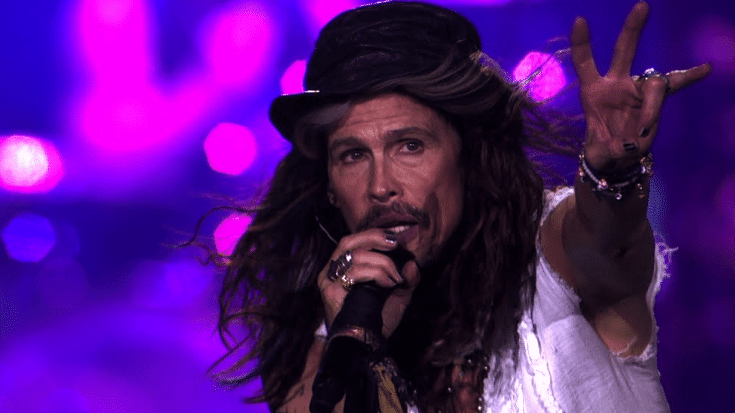10 Dark and Unforgiving Albums From The 70s

via Aerosmith / Youtube
There are numerous variations of classic albums, each with its own distinct style. Some shine as whole works where every track is essential to the whole, while others are chock-full of successful singles. However, not all of these albums are simple to listen to. Whether in their words or the ambiance they produce, many delve deeply into the most sinister, disturbing facets of the human condition.
These records competed with the best performers of the era for a place on the charts, not only appealing to niche markets. However, their material was not at all mainstream. Many listeners at the time may have overlooked the songs’ layers of complexity. Looking back, it’s evident that these musicians were pushing rock music to new heights while tackling some of the most trying emotional situations of their lives.
The time of love and peace was over by now, and something more honest and self-reflective had taken its place. This change in rock music paved the way for its future and had a lasting impact on the business.
10. Welcome to My Nightmare – Alice Cooper
Let’s take a brief detour into something a little more dramatic before delving into the darker side. Known for his startling pranks, Alice Cooper was frequently more macabre than downright frightful. Cooper was able to provide a theatrical insight into his twisted mind even without his band.
It was no small accomplishment to set this record. Cooper and producer Bob Ezrin worked tirelessly to create an album that sounded like a radio-friendly version of Tales from the Crypt after the other members of the band left over creative disagreements. Every song offers a fresh nightmare to investigate. From the harrowing depiction of domestic violence in “Only Women Bleed” to the psychological strain in “Stephen,” the album immerses listeners in unnerving situations.
Before this, Alice Cooper was frequently viewed as a gimmick band that relied more on shock rock humor than on original composition. He rediscovered himself with this record, however, and provided us with an intriguing and unsettling collection. There was definitely space for a bit campy, dark humor in the ’70s rock culture, even though it might not have the horror of The Exorcist.
9. Draw the Line – Aerosmith
Many of the real-life horror tales behind these albums focus more on the mayhem that goes on behind the scenes than they do on the music. On the surface, Draw the Line might seem amazing, but below there’s a profound sense of unrest. For Aerosmith, this album was a watershed. Things started to go apart while the Boston Bad Boys were at the pinnacle of their success.
The band recorded at the Centinel, an abandoned building, however, drug use tainted most of the sessions. Due to his heavy heroin addiction, Joe Perry frequently spent days isolated in his room. The freewheeling spirit of Rocks or Toys in the Attic had been replaced by a more serious intensity when the band finally managed to get together. A deeper, more reflective tone emerged in Steven Tyler’s lyrics, as evidenced by songs like “Draw the Line” and “Kings and Queens.”
The band was obviously beginning to disintegrate, even though some of their songs, like “I Wanna Know Why,” still had the blustery fury of their early years. Perry departed the band in the middle of the tour to pursue a solo career just a few months after the album’s release. Behind the scenes, they were collapsing, but they continued to rock stadiums every night.
8. Wish You Were Here – Pink Floyd
Dark Side of the Moon is a classic song that few musicians would ever want to create. Pink Floyd created one of the most significant records in rock history after years of honing their sound, a feat that would be honored for many years to come. However, there were conflicts in the band when it came time to build on that success and Wish You Were Here became an expression of their annoyances.
This album is extremely emotional, expressing the band members’ understanding of how much fame and the music industry had changed them, as they hardly spoke to one another. Syd Barrett’s shadow looms large, with “Shine On You Crazy Diamond” standing as a heartfelt tribute to their troubled former bandmate. Roger Waters took the lead, and the album takes a cynical tone, criticizing the business’s greed in songs like “Welcome to the Machine” and “Have a Cigar.”
The fact that Syd and the band would never completely rediscover the happiness of their early years only serves to heighten the tragedy. Pink Floyd’s subsequent albums, such as Animals and The Wall, would come out of a place of suffering, and Syd would live in seclusion until his death. The band’s easygoing attitude from their early years was lost, even though they would continue to be successful.
7. Unknown Pleasures – Joy Division
Raw and unabashed nasty was always the goal of punk. Although bands like Billy Idol gave MTV a more polished appearance in the 1980s, the genre’s roots were in horror and nihilism, as shown by the Ramones and The Sex Pistols. Although it was the initial wave of punk, Joy Division expanded the definition of angst into darker, more intimate realms with Unknown Pleasures.
Ian Curtis, one of the forerunners of post-punk, didn’t mince words. In contrast to previous punk bands, where the music and lyrics might have been thematically grim, Joy Division’s sound was a perfect match—caustic and foreboding, almost suffocating, as though the walls were closing in. His lyrics, which frequently reflected his struggles with mental illness, were far from comforting, especially on tracks like “She’s Lost Control.”
For Curtis, this was only the beginning. On Closer, he wrote even more candid songs, but sadly, he committed suicide before the album’s release. Punk’s initial goal was to expose the artificiality of the music industry, but Joy Division’s brief trip and Unknown Pleasures demonstrated what happens when underground music starts to fall apart from the inside out.
6. Raw Power – Iggy Pop and the Stooges
Rock & roll was beginning to adopt a stronger sound as the 1960s drew to an end. Although The Doors had hinted at darker themes in the 1960s, punk was still years away from becoming a major force in New York’s underground culture, and metal had not yet completely developed. Punk was given to life by Iggy Pop’s Raw Power just before anyone could claim the genre’s throne.
Inspired by the heavier side of rock, Iggy puts their all into this album, delivering raw, intense energy on songs like “Search and Destroy” and “Shake Appeal.” James Williamson’s blazing guitar work keeps the energy at a fever pitch from beginning to end, making every song feel like it’s about to collapse but never does. The atmosphere is tight even in the more subdued parts, such as “Gimme Danger,” as though you’ve wandered into the wrong Detroit alley.
Raw Power may not have been a classic when it was released, but there is no denying its impact on punk and metal. This record established the foundation for a more gritty, rebellious sound and served as an unofficial model for innumerable bands. The darkness of Raw Power was a daring shift in the rock scene, and while many were not prepared to hear it, they were unable to ignore it.
5. Station To Station – David Bowie
David Bowie had already experimented with many aspects of his craft by the middle of the 1970s. Following Ziggy Stardust’s glitzy rock extravaganza, he appeared prepared to embark on a new, soulful phase with Young Americans. That was only a precursor, though. The next release was Station to Station, an album that exposed a more raw and sinister side.
With the 10-minute opener hinting at his European influences, Bowie adopted a more electronic, avant-garde style, drawing inspiration from the experimental sounds of krautrock. As usual, Bowie’s albums wouldn’t be complete without a new character, and The Thin White Duke was among his most eerie. Rumors about his Nazi sympathies were stoked by his grim look and unsettling allusions to the occult, which were reinforced by contentious interviews.
Station to Station proved to be a success despite the insanity that surrounded the album’s production—Bowie survived on a strange diet of peppers, milk, and cocaine. The record is a monument to Bowie’s ability to transform excess and turbulence into something magnificent, even though everything pointed to disaster. The aura of darkness pervaded Bowie’s best work, whether it was the result of his cocaine-fueled madness or pure artistic genius.
4. Pink Moon – Nick Drake
Initially, Pink Moon would appear to be an odd choice for such a list. With its soothing, folk-rock sound, it blends in well with musicians like Joni Mitchell and Cat Stevens, who are not associated with dark or unsettling music. However, if you pay great attention, particularly in this day and age, it shows something more profound and disturbing.
The lyrics convey a distinct message, even though the tunes are still lively and ageless. When Nick Drake recorded this album, he was going through a difficult time, and it’s hard to overlook the melancholy and cynicism in his lyrics. Pink Moon might rank among the darkest albums ever produced if the tone of the text and the music were in harmony. Drake’s guitar playing and voice conjure a sort of eerie beauty, yet underneath it all comes a harsh, agonizing truth.
The album’s gentle, serene tone draws you in before delivering a sobering emotional reality. Nick was dealing with actual, severe suffering, even though it might have sounded like a character in the lyrics. He checked himself into a mental health facility after finishing the album, and sadly, he died by suicide a few months later. Pink Moon is a lovely song, but if you listen to the lyrics, you can end up with more than you expected.
3. Suicide – Suicide
In the underground scene, post-punk was already setting the pace before goth rock took over. Bands like Television took things to a new level after the gloomy impact of Joy Division, yet still maintained a reasonably grounded attitude. Suicide then released their debut album, which has a post-punk nightmare tone to it.
This record stretches the boundaries of rock music with its wild atmosphere and glitchy sound. The insane lyrics by Alan Vega only heighten the chaos. The band really pushed the envelope on darker tunes like the 10-minute Frankie Teardrop, while songs like Rocket USA demonstrate their more chaotic approach to rock. With distortion enveloping Vega’s terrifying story about a man named Frankie who kills his family before killing himself, this song has the sense of a horror movie.
Despite its unsettling content, Frankie Teardrop garnered praise, even from Bruce Springsteen, who later gave it his tribute. For punk aficionados, this record was rough, unsettling, and hard to ignore—like a sound version of The Exorcist. It was a visceral experience that took listeners into an unsettling but fascinating area; it was more than just music.
2. Master of Reality – Black Sabbath
Metal wasn’t Black Sabbath’s original goal when they formed in the late 1960s. Their early music had more of a blues rock foundation, but the lyrics had a horror edge. But when Tony Iommi started detuning his guitar and incorporating a deeper, darker edge that would come to define Master of Reality, everything changed.
After Paranoid became a hit, they experimented with this record to see how heavy they could really become. Each track is a nightmare come true, delving into themes of societal breakdown, the afterlife, and more. While Into the Void depicts a somber image of vanishing into nothingness, songs like Sweet Leaf make references to marijuana use.
Master of Reality laid the groundwork for metal’s future beyond the typical blues rock foundation. Bands like Judas Priest quickly rose to prominence, drawing inspiration from Sabbath’s new, harder sound. The album’s change is aptly summed up in the song Children of the Grave, which exposes the Flower Power generation’s misguided ideals. By releasing this album, Black Sabbath officially launched doom metal and put an end to the peace-and-love era, ushering in a new age.
1. Plastic Ono Band – John Lennon
Anyone involved would undoubtedly suffer a great deal of emotional pain when the Beatles broke up, but John Lennon wasn’t worried about offending his fans. After all, he and Yoko Ono had already experimented with some of the most avant-garde music of the day. He faced his inner demons head-on with his first solo album, letting loose a great deal of rage and raw emotion.
A large portion of the CD feels like John releasing his suppressed trauma because he has previously engaged in primal treatment. Every song seems to capture a different aspect of his life; Working Class Hero emphasizes his pessimistic outlook on society, while Mother delves into his unsolved problems with his parents. You can hear him in emotional agony, letting out some of the most powerful screams ever recorded in rock music, in songs like the second half of Well Well Well.
There is a noticeable feeling of suffering even in the more upbeat songs, such as Hold On and Love. John realized that he could only rely on himself, as he articulated in God, and this album served as a means of reestablishing his humanity. This was a harsh reality check for Beatles fans who had been hoping for a reunion. It was time for everyone to move on since the Fab Four’s dream was ended.



















